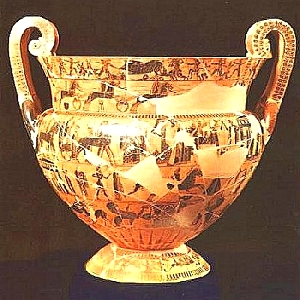I really enjoyed Mike's post about the metal plates and it started me wondering, is there a correlation between the medium used and the kind of document preserved? There are records from the Chinese preserved on wood, bamboo, silk, stone, paper, metal, and ceramic. I hypothesized that more domestic things would be preserved on ceramic, silk, and bamboo while the official institutional documents would be kept on paper, metal, and stone.
"Once upon a time, I, Chuang Chou, dreamt I was a butterfly, fluttering hither and thither, to all intents and purposes a butterfly. I was conscious only of my happiness as a butterfly, unaware that I was Chou. Soon I awaked, and there I was, veritably myself again. Now I do not know whether I was then a man dreaming I was a butterfly, or whether I am now a butterfly, dreaming I am a man." -- Zhuangzi
Saturday, October 22, 2011
Choosing a Medium
Friday, October 21, 2011
European Writing and Art.
Europe is famous for it's philosophy and art. Both are ways in which knowledge and ideas can be passed down and preserved.
 | |||||
| School of Athens painting by Raphael. |
Although technically not an apprenticeship, the teachings of philosophers such as Socrates, Plato and Aristotle (as I mentioned in my previous post) were passed on orally throughout the Greek Civilization. However, the development of various writing systems allowed their philosophies to be written and made available to many others, which lead them to be understood by many others. As a result of being written down, thoughts were preserved not only for the use of those who lived during the Renaissance era, but for the many generations of people who lived after the Renaissance era. Written forms of thoughts also made it easier for one to be taught or tutored by others, since philosophies and actual facts could be referenced without having to be memorized.
 |
| Michelangelo's Pieta. |
Italian artists also continued their trade mainly through relatives or close family friends. Michelangelo, for example, was sent off at a young age to live with a wet nurse who was married to a stone cutter. At a very young age, Michelangelo began to develop a love for stone and as he became older he was taught by the stone cutter how to handle various types of stone. Now, years later, Michelangelo is known for his many famous sculptings such as the "Pieta," "Madonna of the Stairs" and "David."
These sculptures are now records, different than that of a written record, which help us to determine the thoughts and ideologies that Renaissance artists and people in general had about religion and philosophy through the means of emotion.
Through both written philosophy and preserved works of art, we have been able to unravel the ideas and thoughts that Ancient scholars and artists had which have greatly impacted how we, as a Western culture, view the world. How do art and writing, which are both expressive and informative forms of preservation, differ in the ways of how we understand Ancient cultures'? What are some pros and cons to each method of preserving ideas and passing along knowledge?
Thursday, October 20, 2011
Scraping Metal
 |
| This golden disk found in Peru is an contains an inscription of a calendar system. |
"Who didn't write on metal plates?"
Labels:
Ancient Greece,
Dead Sea Scrolls,
Death,
Engravings,
Etruscans,
Hebrews,
Italy,
Korea,
Maya,
Mesoamerica,
Michael Miles,
Orphic Tablets,
Plates,
religion,
Writing,
Written Knowledge
Wednesday, October 19, 2011
The beauty of the text
| Eusebian Canons from the Book of Kells |
 |
| Islamic Calligraphy |
Etruscan Knowledge Institutions
During our unit on oral knowledge, I discussed knowledge institutions within the Etruscan civilization here. Last week, I talked about Etruscan writing and language here. This week, my assignment is to talk about knowledge institutions within the Etruscan civilization, as a part of our unit on written knowledge.
Tuesday, October 18, 2011
The Origins of the Alphabet, Phoenician Style
In the beginning, there were Egyptian hieroglyphs and Mesopotamian cuneiform. From that sprung the 22-letter Phoenician alphabet that is the Mother of every other alphabetic system known to man.
Labels:
Alphabet,
Ancient Egypt,
Ancient Greece,
Education,
Language,
learning,
Morgan Mix,
Mythology,
Phoenicians,
Reinventing Knowledge,
Teaching,
Writing,
Written Knowledge
Monday, October 17, 2011
MAYA GLYPHS: the de facto source of written aesthetisicm
 |
| Vada Creative Studio © 2011 |
Labels:
aesthetic,
glyph,
graphic design,
Vada Creative Studio,
William Myers
Location:
Provo, UT
Subscribe to:
Comments (Atom)


